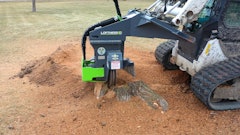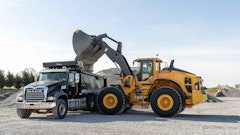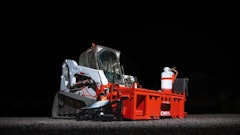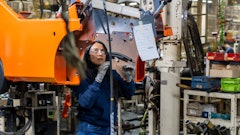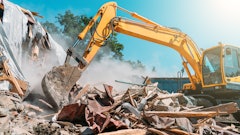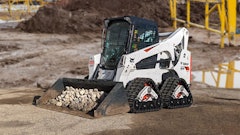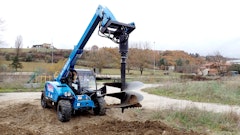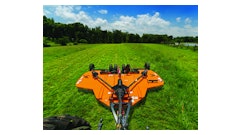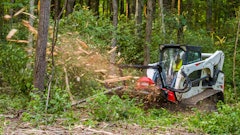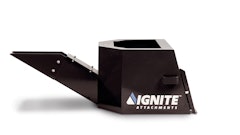When paired with an attachment, a compact excavator becomes a versatile tool carrier that can work in additional applications, handle tasks normally completed by a separate machine and even possibly be the only machine needed on a particular jobsite," says Tom Connor, excavator product specialist with Bobcat Company.
Similar to their cousin, the skid-steer loader, compact excavators are ideal for fitting into small spaces and powering attachments. Unlike skid steers, compact excavators have the added ability to allow the attachment 360-degree access around the machine.
Add an attachment, add productivity
With a quick switch between attachments, your rental customers can break concrete, load the remains into a truck and grade the cleared site - all with the same machine.
With an attachment or two, compact excavators can stay busy on a jobsite all day. "Thinking outside of the box can improve your equipment utilization," says Brian Rabe, compact excavator product manager with Gehl Company. "Most people think of excavators only for digging applications. Their value in other non-digging applications like demolition, landscaping, land clearing and material lift/place/remove applications can add to your bottom line."
While it seems compact excavators and attachments are an ideal pair, keep in mind the boundaries these machines have. There might be a tendency by some rental customers - both contractors and homeowners - to push the limit on attachments because it pushes the utilization of the machine. But pushing the limits can create a situation where these smaller carriers are asked to do too much.
While you want to make the best use of available power, you need to do so within the confines of the machine's specifications to prevent overloading, which can cause overheating and excessive and premature wear, as well as compromise stability.
Determining lift capacity
Your rental customers need to understand that lift capacity of a compact excavator will decrease as the boom extends. If you're operating close to the machine, lift capacity will be greater, for instance. As you extend the arm out to the side and up, the ability of the load to tip the machine will be greater.
On many attachments, the lift capacity of the machine will affect the maximum weight of an attachment that the excavator can use, says Connor.
"For some attachments, such as the clamp or grapple, the lift capacity of the excavator will limit the weight of the material that can be picked up and placed with the machine," he explains. "For example, on a landscaping jobsite where an excavator is being used to place boulders, the weight of a boulder will be limited by the lift capacity of the machine."
So, how much can your compact excavator lift? Some manufacturers print lifting limits on decals affixed directly to the machine. You can also find them printed in most product literature and owner's manuals.
"The key is the values on the lift capacity charts assume the standard bucket is being used," says Connor. "For attachments other than the standard bucket, calculations must be made to reflect a particular attachment in question. A compact excavator will have rated lift capacities for various configurations of the machine, and the lift capacities should be noted to customers and only approved attachments should be rented with the machine."
Optimizing hydraulic flow
A compact excavator is a hydraulically driven machine, as compared to a backhoe-loader, which is horsepower driven. You'll want to ensure that the engine in your machine has enough horsepower to adequately power the hydraulic pump.
"The horsepower of the machine will indicate the machine's ability to produce and sustain adequate hydraulic performance of an attachment - the ability to provide flow (GPM) and pressure (PSI)," explains Connor.
Engine horsepower is an important part of the performance equation, but more horsepower does not necessarily mean more hydraulic performance for the attachments, notes Rabe.
"All functions of a compact excavator require hydraulic flow," he says. "The distribution and efficiency of hydraulic flow dictates attachment performance. It's more important to review the auxiliary hydraulic flow and pressure than to look only at horsepower to ensure the best performance."
The most crucial aspect of the equation is "right-sizing" the machine and the attachment. "You want to ensure that the excavator has the auxiliary flow rate to operate the attachment," says Doug Laufenburg, product marketing manager for attachments at Deere. "It's important to size the attachment to the excavator, and the combination should be sized to do the job desired."
Always match the attachment flow and pressure requirements to the compact excavator, says Rabe. "If an attachment requires more flow than the excavator can deliver, the result can lead to low performance or overheating of the hydraulic system. If an excavator can deliver more flow than the attachment requires, the result can lead to overheating and damage to the attachment. If there is any concern about compatibility, it's best to contact the manufacturer with the application and attachment requirements to ensure safety and the best performance."
Ensuring adequate stability
Oversizing an attachment to speed productivity will not only increase wear on the machine, but it could compromise stability.
For example, in the case of a bucket, upsizing too dramatically can warp the dipper arm and cause the machine to become unstable, especially when working off to the side.
Stability tends to be a greater concern on compact machines because some of them have especially narrow tracks - less than 3 feet wide in some cases - for maneuvering in confined areas.
"A compact excavator that is fitted with an attachment that is over- or undersized for the unit can result in potential unsafe conditions related to lift capacity, machine/attachment hydraulic stress, potential damage to unit and danger to the operator and workers on the jobsite," says Rabe. "It's best to contact the manufacturer with the application and attachment requirements to ensure safety and the best performance.
Buckets remain #1 attachments
Since buckets are still the number one attachment with a compact excavator rental, rental businesses should make sure they have buckets of the width that their market demands.
"Many concrete contractors require a true 12-inch bucket for building footings to spec," says Tom Connor, Bobcat Company. "If they use a wider bucket, the contractor ends up pouring more concrete than required."
Other applications might be subject to local specifications on trench size, for example, which determines bucket size. "It's recommended that rental businesses keep the right-sized trenching buckets in stock to meet the requirements of their area and customers," says Connor.
For rental businessess that plan to rent attachments other than buckets with their compact excavators, a quick attachment system should be considered. "This type of system not only allows quick and easy changing of attachments for the rental house and customer, but ensures the right attachment is rented out with the machine," says Connor.










